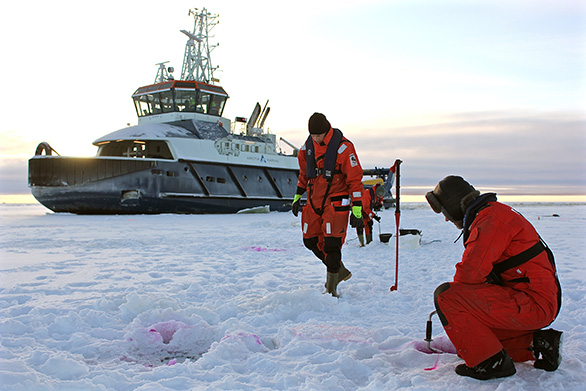Finland leads the climate charge in the Arctic Council

Marine experts in Tornio, northern Finland, drill holes on 5 February 2016 in the sea-ice and inject dye into the water to study how it flows...
If you think the ice looks a little greyer in the Arctic, your eyes are not deceiving you. A five-year study by international researchers has found that diesel-engine vehicles, coal-burning factories and other such fossil-fuelled activities spew out soot, which circles around in the cold air before landing on the snow, turning it from white to sometimes black.
White ice reflects heat; black ice absorbs it and this is melting Arctic ice faster than scientists had anticipated. Researchers say that this soot, otherwise known as black carbon, may account for a half a degree Celsius of Arctic warming. And when the north warms up, the rest of the planet pays.
The Arctic Council, comprising eight circumpolar states including Finland, the US and Russia, has zeroed in on reducing black carbon. “Throughout its chairmanship Finland has dedicated most of its efforts on implementing the Council’s framework programme on black carbon and methane,” writes Timo Koivurova, who is director of the Arctic Centre at the University of Lapland. “The Arctic states were able to agree in the 2017 Fairbanks Arctic Council Ministerial Meeting on a collective political goal to reduce black carbon emissions by at least 25-33% below 2013 levels by 2025.” Targeted reduction of black carbon and other pollutants can cut Arctic warming by 0.2°C by 2050.
Black carbon is just one of the many polar issues the Arctic Council weighs in on. Although the black carbon agreement is voluntary, the Arctic Council has succeeded in catalysing legally binding agreements. The same Fairbanks Declaration includes the Agreement on Enhancing International Arctic Scientific Co-operation whereby members have pledged to co-operate on easing access to the Arctic for scientific research. It joins two other binding agreements ratified by members of the Arctic Council since its founding in 1996: one on marine oil preparedness and response, and another on search and rescue operations in the Arctic.
The Arctic Council’s track record in brokering agreements is important. As the polar ice has been melting and the seas opening up, so strategic interest in the Arctic has been intensifying. There is the commercial promise of shipping routes, fishing, and oil and gas exploration, and military interests too. In fact, compared to the Antarctic, which is protected by the Antarctic Treaty signed in 1959, the Arctic is more or less up for grabs. And as the highest-level multilateral institution in the far north, the Arctic Council will have its hands full keeping members co-operative. The body now accommodates 13 official non-Arctic Observer states, including France, China and India, and the number is sure to grow.
The Arctic Council’s emphasis on the environment owes much to Finnish foresight. “Finland invited the seven other states (Sweden, Denmark, Canada, Iceland, Norway, the US and the USSR) with territories above the Arctic Circle for negotiations that ultimately led to the adoption of the Arctic Environmental Protection Strategy (AEPS) in Rovaniemi, Finland in 1991,” Koivurova remarks. This led to the founding of the council five years later.
Since then, Finland has twice served as the chair of the Arctic Council, which rotates among members every two years. The first time was from 2000 to 2002. Its second chair ends May 2019, after which the gavel will be passed on to Iceland.
The Arctic Council makes no forays into security concerns, but by setting this aside, the council has been able to broker agreements and push research on matters like telecommunications infrastructure, biodiversity and health and mental well-being in Arctic communities. One of Finland’s priorities during this second chair is tackling climate change. It organised the Arctic Resilience Forum in September 2018, during which participants in the region worked on practical ways to increase resilience to risks posed by climate change. Finland has also pressed for greater meteorological co-operation between the Arctic states and the World Meteorological Organization to achieve more accurate climate scenarios.
Finland is also leading important work on methane, and raising global awareness that black carbon has a strong warming impact. Curiously, black carbon levels are not regulated under the UN climate change regime whose purview is over molecules like CO₂ that linger in the earth’s atmosphere for a long time. In contrast, a particle of soot stays in the atmosphere for a much shorter time—about a week—and is regulated by air pollution laws instead. Yet, the effect of soot on Arctic ice so profoundly influences global warming that black carbon may be included in future commitments on nationally determined contributions under the Paris Agreement. Following the 2017 Fairbanks Declaration, the Arctic Council is now preparing another set of recommendations to be presented to foreign ministers in May 2019.
The Arctic Council’s influence goes beyond the far north, since the 13 observer-status countries may also undertake black carbon and methane reductions in their own countries. Some are already providing black carbon and methane inventories and reporting on their black carbon reductions.
Some six indigenous organisations also sit on the Arctic Council. Although these actors do not have the same status as country members—they are Permanent Participants—they help shape the agenda. The council’s unique hybrid structure and history of working together has produced important Arctic norms in the past 23 years. But with activity ramping up, the Arctic needs its peoples and states to co-operate all the more. What the Arctic Council has accomplished so far is, hopefully, just the tip of the iceberg of what is to come.
©OECD Observer March 2019
https://arctic-council.org/ https://arctic-council.org/
www.sciencedaily.com/releases/2019/02/190220121935.htm www.sciencedaily.com/releases/2019/02/190220121935.htm
